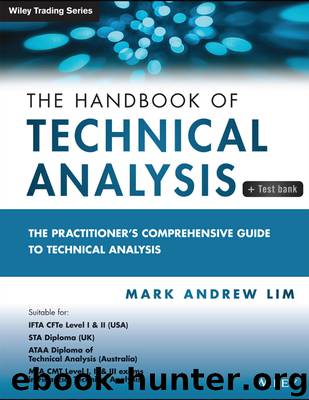A Handbook of Technical Analysis by Lim Mark Andrew;

Author:Lim, Mark Andrew;
Language: eng
Format: epub
ISBN: 9781118498927
Publisher: John Wiley & Sons, Incorporated
Published: 2015-09-08T00:00:00+00:00
(1) Simple Moving Average
A simple moving average (SMA) is the most basic form of a moving average and is calculated by first dividing the sum of all prices by its number of periods. Let N equal the lookback period:
This average value is then rolled forward to the next most recent closing price, dropping off the oldest closing price in the previous range and adding to it the latest closing price. This process is repeated indefinitely and thus forms the moving or rolling average. Sometimes the effect of dropping off the last price may cause the moving average to swing erratically, especially if the value dropped off was relatively large. Increasing the lookback period or increasing the sensitivity of the moving average to recent prices via the use of front-weighted moving averages will help reduce the impact of the drop-off effect on the moving average.
The weighting factor for each period is equal, with each price having an equal impact on the average value. The percentage of contribution or influence that each period has on the SMA is (100/N) percent.
So, for a 10 period SMA, the price corresponding to each period has a (100/10) = 10 percent contribution or impact on the average price. See Figure 11.7 for an example of a 10-day SMA. The last column on the right represents the moving average of the last 10 days on the Chicago Board Options Exchange (CBOE) Interest Rate 10-Year Treasury Note, beginning on May 29, 2009. Figure 11.8 is a plot of the moving average.
Download
This site does not store any files on its server. We only index and link to content provided by other sites. Please contact the content providers to delete copyright contents if any and email us, we'll remove relevant links or contents immediately.
The Black Swan by Nassim Nicholas Taleb(6943)
Bad Blood by John Carreyrou(6474)
Pioneering Portfolio Management by David F. Swensen(6168)
Millionaire: The Philanderer, Gambler, and Duelist Who Invented Modern Finance by Janet Gleeson(4290)
Skin in the Game by Nassim Nicholas Taleb(4121)
The Money Culture by Michael Lewis(4024)
Bullshit Jobs by David Graeber(3991)
Skin in the Game: Hidden Asymmetries in Daily Life by Nassim Nicholas Taleb(3867)
The Wisdom of Finance by Mihir Desai(3604)
Blockchain Basics by Daniel Drescher(3428)
Liar's Poker by Michael Lewis(3316)
Fooled by Randomness: The Hidden Role of Chance in Life and in the Markets by Nassim Nicholas Taleb(2971)
The Intelligent Investor by Benjamin Graham Jason Zweig(2964)
Hands-On Machine Learning for Algorithmic Trading by Stefan Jansen(2964)
Mastering Bitcoin: Programming the Open Blockchain by Andreas M. Antonopoulos(2949)
Investing For Dummies by Eric Tyson(2831)
The Power of Broke by Daymond John(2830)
Market Wizards by Jack D. Schwager(2587)
Zero Hour by Harry S. Dent Jr. & Andrew Pancholi(2562)
